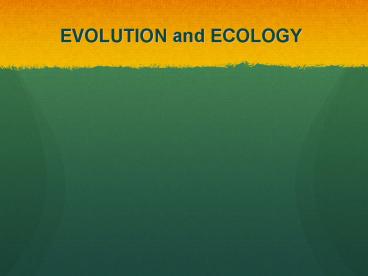EVOLUTION and ECOLOGY PowerPoint PPT Presentation
1 / 25
Title: EVOLUTION and ECOLOGY
1
EVOLUTION and ECOLOGY
2
BIODIVERSITY
3
Climate zones determine communities
Figure 5-2
4
Terrestrial biomes
Figure 5-9
5
Ecological niche
- An organisms role in its community
- Includes
- what it needs to survive
- Nutrients
- Light
- Space (habitat)
- Oxygen or carbon dioxide
- Inorganic compounds
- How it interacts with other species
- The more available niches there are to fill, the
greater the amount of organisms
6
Niche diversification in African Rift Lake
Cichlids
7
Model of Cichlid Fish Diversification
8
Other examples of ecology influencing evolution
- Coevolution two species evolve in response to
each other over time - Pollinators and flowering plants
- Hosts and parasites
- Predators and prey
- Symbioses
- Competition
Hammer orchid
9
Predation drives evolution of both predators and
prey
- Predators adaptations
- Locate, sneak up on subdue prey
- Prey adaptations
- elude defend
horns, speed, coloration
spines, thorns, toxins
10
Symbiotic interactions
- parasitism (-/)
- mutualism (/)
- lichens (algae fungus)
- commensalism (/0)
- barnacles attached to whale
11
Competition can affect niches
High tide
Species 1
Low tide
Chthamalus sp.
Species 2
Fundamental niches
Realized niches
Semibalanus sp.
12
Ecosystems
13
Two Necessities for Survival Energy Flow and
Matter Recycling
14
Producers Basic Source of All Food
- Most producers (autotrophs) capture sunlight to
produce carbohydrates by photosynthesis
15
Consumers Eating and Recycling to Survive
- Consumers get their food by eating or breaking
down all or parts of other organisms or their
remains. - Herbivores (primary consumers)
- Carnivores
- Omnivores
16
Respiration Getting Energy for Survival
- Organisms break down carbohydrates and other
organic compounds in their cells to obtain the
energy for internal reactions. - This is done through aerobic respiration or
anaerobic respiration.
17
Decomposers and Detrivores
18
Energy Flow
- Energy flows through an ecosystem
- Route of energy flow is determined by an
ecosystems trophic structure. - Trophic interactions move energy through an
ecosystem
Simple example
19
(No Transcript)
20
Humans can impact natural food webs
- Chemical pollutants
- Invasive species
- Overhunting
21
Energy Flow in an Ecosystem Losing Useful Energy
in Food Chains and Webs
22
MATTER CYCLING IN ECOSYSTEMS
- All organisms are made up of organic molecules
- Carbohydrates
- Proteins
- Lipids
- Nucleic acids
- Essential nutrients are those that are required
to make the organic molecules - C, H, N, O, P, S
- Organic matter cycles within ecosystems
(biogeochemical cycles) - Both autotrophs and decomposers play vital roles
23
Carbon Cycle
24
The Nitrogen Cycle Bacteria in Action
25
Phosphorus cycle

